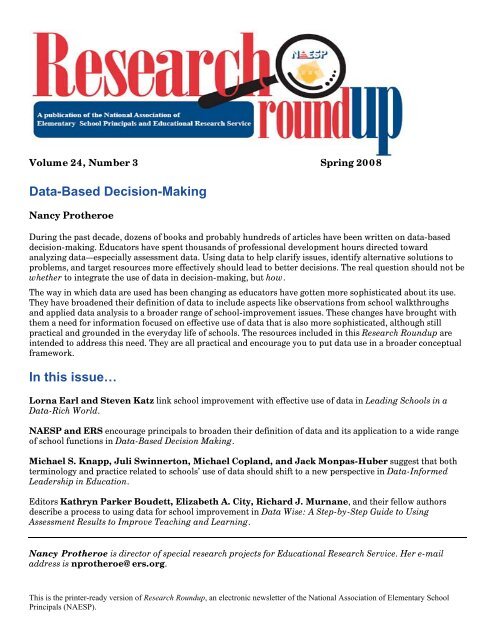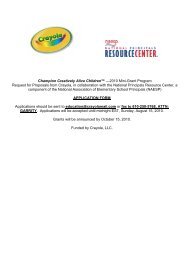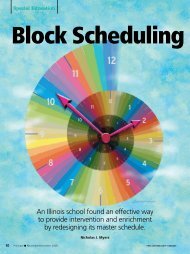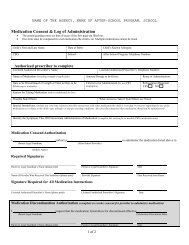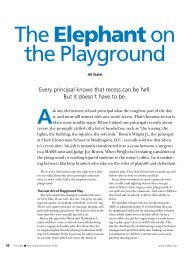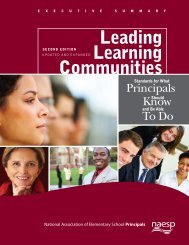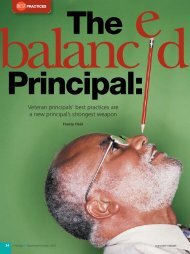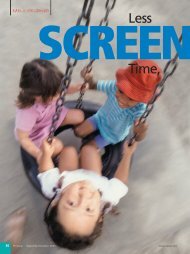Data-Based Decision-Making - National Association of Elementary ...
Data-Based Decision-Making - National Association of Elementary ...
Data-Based Decision-Making - National Association of Elementary ...
You also want an ePaper? Increase the reach of your titles
YUMPU automatically turns print PDFs into web optimized ePapers that Google loves.
NAESP : <strong>Data</strong>-<strong>Based</strong> <strong>Decision</strong> <strong>Making</strong> (second edition)http://www.naesp.org/ContentLoad.do?contentId=2474&action=printPage 1 <strong>of</strong> 13/24/2008<strong>Data</strong>-<strong>Based</strong> <strong>Decision</strong> <strong>Making</strong> (second edition)Research Roundup » Volume 24, Number 3, Spring 2008NAESP and ERS. <strong>Data</strong>-<strong>Based</strong> <strong>Decision</strong> <strong>Making</strong> (second edition). Alexandria, VA: <strong>National</strong><strong>Association</strong> <strong>of</strong> <strong>Elementary</strong> School Principals. 2008. Available from NAESP. $19.95 forNAESP members; $26.95 for nonmembers. 800-386-2377. www.naesp.org.<strong>Data</strong>-<strong>Based</strong> <strong>Decision</strong> <strong>Making</strong> is a new edition <strong>of</strong> a very popular title in the NAESPEssentials for Principals series. Almost all the content is new and reflects the evolvingpractices <strong>of</strong> schools with regard to data use. <strong>Data</strong>-<strong>Based</strong> <strong>Decision</strong> <strong>Making</strong> begins with a briefintroduction to the importance <strong>of</strong> data use in supporting school-improvement efforts and thenmoves on to a discussion <strong>of</strong> some preconditions needed for school staff members to use dataeffectively:• A trusting environment in which people feel comfortable talking about and studyingschool- or classroom-based problems;• Training that emphasizes skill-building through actual use <strong>of</strong> data in authentic taskssuch as grade-level team review <strong>of</strong> student progress;• Opportunities for teachers and other staff members to collaborate in analyzing data andsolving problems; and• Development <strong>of</strong> a culture <strong>of</strong> data use through a principal’s demonstration that data areused daily to help support decision-making about small and large issues.Although most schools begin more intensive data use with assessment data, there are manyother areas <strong>of</strong> school operations that can be supported by data. <strong>Data</strong>-<strong>Based</strong> <strong>Decision</strong> <strong>Making</strong>discusses a few <strong>of</strong> these other areas and suggests:You and your staff could probably brainstorm dozens more in just a fewminutes. Remember that such endeavors need not be “big” projects. Many timesthe data question can focus on a small and manageable concern. However,addressing this small concern through careful study can <strong>of</strong>ten have big pay<strong>of</strong>fs.One <strong>of</strong> the areas discussed in this book is principals’ classroom observations, which arestrong potential sources <strong>of</strong> data about instruction:One <strong>of</strong> a principal’s most important responsibilities is ensuring that qualityteaching is happening in every classroom. Obviously, student performance onthe required year-end assessments is one source <strong>of</strong> data about the quality <strong>of</strong>instruction. But waiting until such data are available would mean many months<strong>of</strong> missed opportunities to help teachers improve their instructional skills. Theonce-a-year checklist observations <strong>of</strong> teachers used by many districts forevaluation purposes also suffer from the “too little, too late” problem.<strong>Data</strong>-<strong>Based</strong> <strong>Decision</strong> <strong>Making</strong> goes on to describe a system <strong>of</strong> classroom observation andteacher feedback that can help principals strengthen their role as instructional leader. In thissystem, short, frequent visits to classrooms yield data about what happens on a day-to-daybasis—data that can be used to strengthen instruction on an almost continual basis.
NAESP : <strong>Data</strong> Wise: A Step-by-Step Guide to Using Assessment Results to Improve Tea...http://www.naesp.org/ContentLoad.do?contentId=2476&action=printPage 1 <strong>of</strong> 13/24/2008<strong>Data</strong> Wise: A Step-by-Step Guide to Using AssessmentResults to Improve Teaching and LearningResearch Roundup » Volume 24, Number 3, Spring 2008Kathryn Parker Boudett, Elizabeth A. City, and Richard J. Murnane (editors). <strong>Data</strong> Wise: AStep-by-Step Guide to Using Assessment Results to Improve Teaching and Learning.Cambridge, MA: Harvard Education Press. 2005. 212 pages. $29.95. Companion volume:<strong>Data</strong> Wise in Action: Stories <strong>of</strong> Schools Using <strong>Data</strong> to Improve Teaching and Learning.2008. 220 pages. $29.95. Both available from Harvard Education Publishing Group. 888-437-1437. www.hepg.org.In <strong>Data</strong> Wise: A Step-by-Step Guide to Using Assessment Results to Improve Teaching andLearning, editors Boudett, City, and Murnane introduce a process for assessment data use.The process is organized around eight distinct activities that fall into three general categories:• Prepare: Organize for collaborative work and build assessment literacy;• Inquire: Create a data overview, dig into student data, and examine instruction; and• Act: Develop an action plan, plan to assess progress, and act and assess.While the chapters are written by several authors, they all use the framework <strong>of</strong> the model tolink concepts together. For example, authors <strong>of</strong> the “Examining Instruction” chapter build onthe previous discussion about the “learning problem” a school might have identified, writing:“The learning problem you have articulated by this step <strong>of</strong> the improvement cycle is acomplicated problem—if it were an easy one, you would have solved it by now.” They thengo on to suggest that the learning problem should be reframed as a “problem <strong>of</strong> practice.” Inother words, how can teaching help address this problem? Four guiding questions areprovided to help with this:• With this particular learning problem, how does instruction impact what studentslearn?• How do we look at instructional data?• What does effective instruction for our learning problem look like and what makes iteffective?• What is actually happening in the classroom in terms <strong>of</strong> the learning problem, and howdoes it relate to our understanding <strong>of</strong> effective practice?The editors stress that the process is intended to be cyclical. Once schools learn from and acton assessment results, they should cycle back to ask additional questions. However, the bookis intentionally designed so individual chapters, each <strong>of</strong> which focuses on one <strong>of</strong> the eightactivities, can stand alone. It could also be used to support a yearlong focus for a school staffwanting to hone their data-use skills.A strength <strong>of</strong> this book is its use <strong>of</strong> real-life examples to demonstrate the elements <strong>of</strong> theprocess. A companion volume—<strong>Data</strong> Wise in Action: Stories <strong>of</strong> Schools Using <strong>Data</strong> toImprove Teaching and Learning—expands on the discussion <strong>of</strong> <strong>Data</strong> Wise in practice. It usescase studies from eight schools to demonstrate the use <strong>of</strong> the <strong>Data</strong> Wise process <strong>of</strong> usingassessment results to improve teaching and learning.
Additional Online Resourceswww.mcrel.org/PDF/SchoolImprovementReform/5982TG_AskingRightQuestions.pdfAsking the Right Questions: A Leader’s Guide to Systems Thinking about School Improvement was developedby Mid-Continent Research for Teaching and Learning “to help school leaders, particularly principals, thinksystematically as they examine school improvement.” The short report (34 pages) includes questions schoolscan use to jump-start a self-evaluation process.www.naesp.org/ContentLoad.do?contentId=1455This Principal article, “How Assessment <strong>Data</strong> Can Improve Instruction,” is available to members on theNAESP Web site. It briefly discusses topics such as “Assessment <strong>Data</strong> as a Tool for Instructional Improvement”and “Implementing Effective Classroom Assessment Practices.”www.aasa.org/files/PDFs/Publications/Using<strong>Data</strong>ToImproveSchools.pdfAlthough written from a school district perspective, Using <strong>Data</strong> to Improve Schools: What’s Working includesdiscussions that could easily be adjusted to school-level needs. For example, one section begins by stating,“One <strong>of</strong> the biggest challenges for any district implementing data-driven decision making is knowing where tobegin,” and then provides suggestions for ways to move toward effective data use.www.ael.org/dbdm/overview.cfmThe Council <strong>of</strong> Chief State School Officers and Advantia have collaborated to develop <strong>Data</strong>-<strong>Based</strong> <strong>Decision</strong><strong>Making</strong>, a Web-based resource for educators. The site is organized around major components <strong>of</strong> the data useprocess, supplemented by key questions. For example, one section is titled “What must be considered whensetting data-based goals?” Each <strong>of</strong> the sections includes a brief response to the organizing question, anexample, and stories <strong>of</strong> actual schools’ uses <strong>of</strong> data.About NAESPEstablished in 1921, NAESP has grown to become the most powerful voice <strong>of</strong>pre-K-8 principals across the United States and around the world. NAESP leads in the advocacy and support forelementary and middle-level principals and other education leaders in their commitment to allchildren. www.naesp.orgAbout ERSEducational Research Service (ERS) is the nonpr<strong>of</strong>it organization serving the research andinformation needs <strong>of</strong> the nation’s K-12 education leaders and the public. Founded in 1973 by NAESPand six other national school management associations, ERS serves as the research arm for NAESP.www.ers.orgLinks from the NAESP Web site to other sites do not constitute endorsement by NAESP for any <strong>of</strong> their contents.Published by:<strong>National</strong> <strong>Association</strong> <strong>of</strong> <strong>Elementary</strong> School PrincipalsMember Services1615 Duke St.Alexandria, VA 22314-3483Phone: 703-684-3345Fax: 703-549-5568www.naesp.orgThis is the printer-ready version <strong>of</strong> Research Roundup, an electronic newsletter <strong>of</strong> the <strong>National</strong> <strong>Association</strong> <strong>of</strong> <strong>Elementary</strong> SchoolPrincipals (NAESP).


